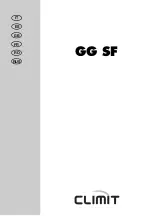
12
5
Your installer will advise you of any actions you should take to
ensure that the satisfactory and efficient operation of the heating
and hot water systems connected to the boiler are maintained.
CENTRAL HEATING SYSTEM
During the first few hours of operation of the central heating
system, check that all radiators are being heated at an even rate.
Should the upper area of a radiator be at a lower temperature than the
base of the radiator, it should be vented by releasing air through the
venting screw at the top of each radiator. Make sure your installer
shows you how to carry out the operation. Repeated venting will
reduce the quantity of water in the system and this must be
replenished for safe and satisfactory operation of the appliance.
Should water leaks be found in the system or excessive venting be
required from any radiator, a service engineer should be contacted and
the system corrected.
CLEARANCES
Your installer will
have provided adequate
space around the appliance
for safety and servicing. Do
not restrict this space by
the addition of cupboards,
shelves etc. closer to the
appliance.
Minimum clearances in millimetres.
ROOM THERMOSTAT
A room thermostat may be fitted for control of the central heating
temperature. It will be located in one room of the home. The method
of setting a room thermostat varies with the type and manufacture.
Refer to the instructions supplied with the room thermostat.
PROGRAMMER/CLOCK
A programmer or clock may have been fitted to the system: the
method of setting varies with the type and manufacturer.
Refer to the instructions supplied with the control.
THERMOSTATIC RADIATOR VALVES
If thermostatic radiator valves are to be fitted to the system then
they must conform to the requirements of BS2767:1972. It is advisable
to leave one valve permanently set at maximum to prevent the boiler
short cycling.
GENERAL NOTES
9
8
OPERA
TION OF
CONTROLS
More than 30% of all calls made to Worcester Heat Systems to
report appliance faults or breakdowns prove to be false alarms, as there
is often a simple explanation for the apparent malfunction.
So, to help you save time and money – not to mention frustration
and inconvenience – please refer to the General Information, Notes and
Lighting Instructions ensuring all controls are set correctly.
If, after following the instructions the appliance still fails to operate
correctly call the Worcester Heat Systems Service Centre. Arrangements
will be made for an engineer to call as soon as possible.
CALL-OUT CHARGES
All of our field service engineers are factory trained.
If you request a visit from an engineer and your appliance has been
installed within the last 12 months, no charge will be made for parts
and/or labour, providing:
•
The appliance was commissioned correctly on installation.
•
An appliance fault is found and the appliance has been installed
within the past 12 months.
A call-out charge will be made where:
•
The appliance has been installed for over 12 months, or
•
Our Field Service Engineer finds no fault with the appliance (see
note), or
•
The cause of breakdown is with other parts of your
plumbing/heating system, or with equipment not supplied by Worcester.
NOTE:
Invoices for attendance and/or repair work carried out on
your appliance by any third party will not be accepted.
APPLIANCE FAILS TO
OPERATE
Fig. 1. Controls.
BOILER HEATING TEMPER
ATURE
CONTROL
The position of this knob will determine the temperature of the
water delivered from the appliance between the
start of the dial as
indicated thus '
'
and the
fully on
position i.e. when the knob is
turned fully clockwise. When the knob is turned fully anti-clockwise
to the
‘O’
position the appliance is off.
BOILER RESET BUTTON
If the lockout light is on or flashing, turn the control knob fully
anticlockwise to the '
O
' position and back on again. If the appliance
still fails to operate then contact Worcester Heat Systems or your
installer.
Boiler
demand
Temperature
control knob
15CBi
24CBi
Left-hand side
5
5
Right-hand side
5
5
In Front
600
600
Above
180
180
Below
200
200
Burner
on
Lock-out


































